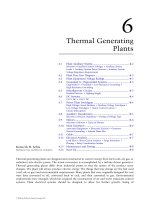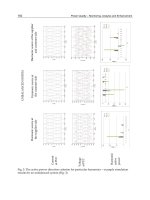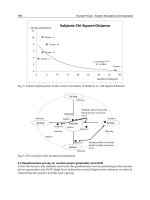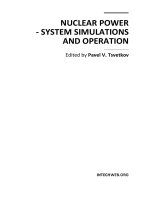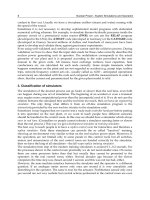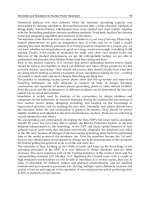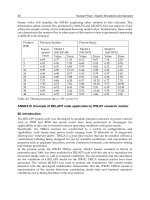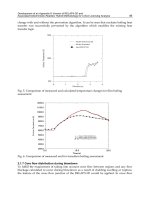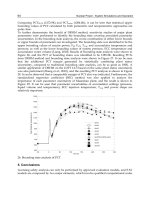Nuclear Power System Simulations and Operation Part 8 pdf
Bạn đang xem bản rút gọn của tài liệu. Xem và tải ngay bản đầy đủ của tài liệu tại đây (506.64 KB, 15 trang )
Nuclear Power - System Simulations and Operation
94
• Preparing the qualification matrix.
• Executing assessment calculations.
• Performing comparison and final evaluation.
Table 1. Ascó configurations
The qualification matrix is prepared by establishing a list of plant transients suitable for
qualification and another list of systems and components needed for advanced qualification.
The first list is prepared in a comprehensive way. Some decisions can be made in order to
obtain a good level of qualification with reasonable effort. Some configuration can be
interesting due to the number of unexpected transients but the engineering effort to
maintain the corresponding model could be excessive. In this case, it is better to discard the
configuration provided that there are sufficient recorded transients in the rest of the
configurations.
The second list has to be prepared to identify which systems and components have had a
significant effect on the transients analysed to date or intended to be analysed in a near
future. Following what has been established in the previous section, this includes a complete
set of calculations related to PSA and others to EOP analysis.
Once both lists were ready, the information was organized, as can be seen in Figures 5 and
6. The former is the qualification matrix and the latter shows a detailed part of it. Each
transient is set to a column (i) and each system or component to a line (j). In the box
corresponding to column i and line j, one or two names of parameters are set. These are the
key parameters to check the correct functioning of system j, which is properly recorded in
transient i.
If the key parameter of a system or component is properly documented in more than one
transient, the input is adjusted to simultaneously match, or at least to reasonably approach,
all the different recorded behaviours. In this way the matrix helps the analyst to keep track
of his experience and make it useful for future modelling tasks.
Thermal-Hydraulic Analysis in Support of Plant Operation
95
Fig. 5. Qualification matrix
Fig. 6. Detailed box of the qualification matrix
Nuclear Power - System Simulations and Operation
96
The matrix is also helpful for new studies. The analyst, knowing the relevant aspects of the
scenario to be studied, could easily check in the table if the model used is properly qualified.
The matrix can also be easily enhanced either by adding columns related to new suitable
transients or adding new lines related to systems needed for qualification.
4. Example cases
This section briefly presents some relevant results of one example of analysis performed
along with the concise description of other two cases. All the considered cases are related to
actual situations in which the scenarios were studied by analysts using thermal-hydraulic
codes and prepared nodalizations.
The example presented is the analysis of a reactor trip operating event due to high variation
of neutron flux occurred in the Vandellòs-II NPP. More detail can be found in (Reventós
2010).
The transient was initiated by an electrical grid disturbance due to a storm, which caused
disconnection of the main output switch, while the in-site electrical equipment switch
remained connected. The plant therefore started operating on auto-consumption. Due to the
loss of off-site power, the reactor and the turbine tripped and natural circulation was
established. Later on, off-site power was recovered and operators brought the plant to Hot
Zero Power (HZP).
The initial phase started with the loss of off-site power and lasted until the reactor trip. The
sequence of events that caused the shutdown of the reactor lasted less than 1.0 second and is
not easily studied mainly because of the short time of occurrence and also because of the
relatively high time step of the collected time-trends. The post-trip event list did not help
much.
The only symptom that pointed to a credible explanation was related to some primary flow
data recorded by plant instrumentation. These data revealed that in 2.0 seconds the primary
flow increased by about 4 or 5%.
Since the plant was on auto-consumption, the electrical frequency could have increased and
could have resulted in the subsequent increase of the Reactor Coolant Pump (RCP) speed.
This suspicion needed to be confirmed. A calculation was performed in order to corroborate
this hypothesis.
In order to approximate their real behaviour, different values of RCP speed were introduced
in the BE model as a boundary condition until the primary flow increased by about 4 or 5%,
as had been observed in the plant. This flow increase produced a decrease in moderator
temperature that could not be measured by usual temperature instruments (Figure 7) in the
first second after the initiating event.
A calculation, using an Integral Plant Model, produced the evolution of temperature node
by node for the whole core. Results were analyzed for all nodes and the temperature
corresponding to the central node is shown in Figure 8. This decrease in core temperature
produced an increase in power due to the effect of moderator temperature (Figure 9). This
figure shows the power increase until the inflection due to the beginning of rod insertion at
0.6 seconds and the full decrease of power after time=1.0 second as an effect of the negative
reactivity introduced. It must be pointed out that the time of insertion is about 1.5 seconds
which is consistent with the power time trend.
Thermal-Hydraulic Analysis in Support of Plant Operation
97
Fig. 7. Calculated average temperature
Fig. 8. Calculated temperature of core central node
Nuclear Power - System Simulations and Operation
98
Fig. 9. Calculated nuclear power
Although the neutronics of the Integral Plant Model used, is usually not very detailed (it is a
point-kinetics model), it is capable of predicting the increase in reactor power due to
moderator temperature decrease and, as a consequence, the reactor trip due to high
variation of neutron flux.
The model has been extremely useful in clarifying the sequence of events corresponding to
the transient that actually occurred in the plant on December 2, 1991. The study provided an
answer to the concerns of the person responsible for operation related to the scenario and
was also helpful to identify the inadequacy of thermocouple location as a design deficiency.
This identification was a necessary step previous to its replacement that took place soon
after the event.
The analysis is a good example of how integral plant models can result in a real benefit as
part of the support activities to the operation of a nuclear power plant.
The transient was included in the Qualification Matrix and it is currently being re-analyzed
after any major change performed in the model.
Operating events, as the one depicted above, are maybe the most significant analyses
performed for support of plant operation. Other cases are analyzed. Two concise descriptions
are presented below.
Some analyses are performed, as the one that follows, in strong connection to both EOP and
PSA. Studies like this one are maybe not the more significant but they are for sure the most
usual. The studied sequence consists in a total loss of Feed Water (FW).
EOP/PSA transient analyses are traditionally performed using Integral Plant Models.
Results were a successful first approach to operation support and the study was carried out
following some concern of the person responsible of plant operation. More detail on the
analysis can be found in (Reventós, 2007b).
Thermal-Hydraulic Analysis in Support of Plant Operation
99
After the total loss of FW takes place, heat transfer from the primary to the secondary side
degrades and causes a decrease of the SG level. Once this symptom has been detected, the
procedure starts by opening 1 PORV and actuating 1 HPIS train. Water injected into the
primary system at low temperature is heated by decay power and comes out through the
relief valve. The procedure results in a pressure decrease which means that energy
produced is completely extracted.
The base case brings the plant to a safe situation without violating design limits as hot rod
clad temperatures show a general decreasing trend during the whole transient. The
calculation properly captures the main relevant thermal-hydraulic features of the scenario.
Once the base case was successfully simulated, a strategy was defined to answer the
following questions:
• Impact of PORV and HPIS partial availability (less than 2 PORV or 2 HPIS trains)
• Maximum time to start the procedure after the level symptom occurs
• Relevant heat sink recovery phenomena (although recovery actions are quite fast, they
involve different components and need some time)
The answers to the questions were obtained and the operation team got a better general
picture of the scenario and related phenomena. As obviously each answer has an impact on
the others, the strategy applied was to launch quite a large number of combined scenarios in
order to cover different situations that could potentially occur. For a given combination of
component availability, a series of different procedure starting times have been tried and for
each of these calculations heat sink recovery was also imposed at different times. The total
number of cases was 61. In this case the complete set of calculations was performed by the
analyst.
The next concise description presented in the current context is not related to transient
analysis but to slow degradation of a very significant component: the steam generators of a
PWR plant. The study was carried out for Ascó NPP.
Due to some problems related to the material used in manufacturing steam generator tubes,
degradation was taking place and the probability of having a tube rupture was increasing
from cycle to cycle. To face the problem the team giving support to plant operation, started
with different engineering actions, most of them were design modifications related to the
chemistry of the secondary circuit devoted to replace materials that were supposed to power
corrosion. At each reload an Eddy current extensive inspection was carried out in order to
quantify the degradation and as a consequence to make a decision on which tubes needed to
be plugged. The problem was quite serious because in few years the number of plugged
tubes increased at an important rate.
Using the Integral Plant Model of Ascó NPP, an analysis was carried out. The results
obtained became interesting information to help decision making. The work done faced both
realistic modelling of actual situations and predictive simulation of eventual future
plugging.
After each reload and following the actual tube plugging, the plant model was adjusted with
realistic criterion. The specific development of the model was to decrease heat exchange
surface from primary to secondary side and also to reduce the primary flow area following
the actual plugging. The model stabilized at a slightly different working point. Maybe the
more interesting parameters to check were the secondary pressure and the stabilized
position of turbine valve. Such stable values of Pressure and valve position are shown in
Figure 10 along with model predictions as a function of plugging percentage. Checking and
comparing such parameters provided additional validation for the specific situation. The
validated model could then be used for the usual purposes maintaining its accuracy.
Nuclear Power - System Simulations and Operation
100
Fig. 10. Secondary pressure and turbine valve position vs. SG tube plugged percentage
Fig. 11. Thermal power vs. SG tube plugged percentage
Thermal-Hydraulic Analysis in Support of Plant Operation
101
The predictive simulation of eventual future plugging was even more interesting.
Symmetric and asymmetric configurations were modelled at an increasing plugging
percentage and key parameters were evaluated. When plugging percentage increased
secondary pressure decreased and turbine valve stabilized at a wider position to
compensate and allow the nominal value of steam mass flow (see Figure 10). Once turbine
valve at certain plugging percentage reached the fully wide open position the secondary
system stopped being able to extract all the thermal power produced. As shown in Figure
11, higher plugging percentages resulted in a thermal power smaller than the nominal one.
The predictive simulation gave quite clear results about 3 o 4 cycles (at that time Ascó follow
12 months cycles) before the eventual decrease of thermal power. The results of this
analysis, along with other technical studies, became extremely helpful for making the
decision of steam generator replacement. The decision was made on time and the
replacement was carried out successfully.
5. Conclusions
This chapter has shown the relevance of thermal-hydraulic analysis devoted to give support
to plant operation. Integral Plant Models prepared using system codes, and properly
qualified, are a valuable tool to carry out the studies presented.
It has also been shown the significance of tasks to be performed by the so called
thermalhydraulic analyst supporting plant operation. If this analyst belongs to the technical
team that takes care of engineering plant support, his studies become more effective.
Taking care of plant models and personally performing at least the first approach analysis of
any of the issues involved, is a suitable strategy. Depending on the amount of work needed
for each specific analysis, the whole work or only a part of it is done by him. Benefits are
clear in both cases.
The examples presented or briefly described illustrate the job of performing termalhydraulic
calculations as a first approach of the analysis of plant dynamic behaviour.
6. Acknowledgement
The examples presented in this chapter are related to the NPPs of Ascó and Vandellòs-II
operated by ANAV. The author is grateful to the management and the staff of the ANAV for
their consent to this publication.
7. References
Ashley R., El-Shanawany M., Eltawila F., D’Auria F., November 1998. Good Practices for User
Effect Reduction. NEA/CSNI/R(98)22.
Berthon A., Petruzzi A., del Nevo A., Reventós F., September 2005. Consistent code
qualification process and application to the LOBI test BL-44. IAEA Technical Meeting
on: Use of a Best Estimate Approach in Licensing with Evaluation of Uncertainties; Pisa,
September 2005
IAEA, 2002. Accident Analysis for Nuclear Power Plants. Safety Report Series No. 23.
International Atomic Energy Agency. Vienna.
IAEA Safety Reports Series Nº 48, 2006. Devepolment and Review of Plant Specific Emergency
Operating Procedures.
Nuclear Power - System Simulations and Operation
102
Llopis C., Casals A., Pérez J., Mendizábal R., December 1993. Assessment of RELAP5/MOD2
against a main feed water turbo pump trip transient in the Vandellòs-II NPP.
International Agreement Report. Nureg/ia-110
Llopis C., Pérez J., Casals A., Mendizábal R., May 1993. Assessment of RELAP5/MOD2 against
a 10% load rejection transient from 75% steady state in the Vandellòs-II NPP.
International Agreement Report. Nureg/ia-109
Llopis
C., Reventós F., Batet L., Pretel C., Sol I., March 2007. Analysis of Low Load
Transients for the Vandellòs-II NPP. Application to Operation and Control
Support. Nuclear Engineering and Design, 237 (2007) 2014-2023
Martínez V., Reventós F., Pretel C., Sol I.; Code Validation and Scaling of the ROSA/LSTF
Test 3-1 Experiment; Topsafe 2008 – European Nuclear Society; Dubrovnik, Croatia,
September-October 2008
A. Petruzzi, F. D’Auria, W. Giannotti, “Description of the procedure to qualify the
nodalization and to analyze the code results”, May, 2005.
Posada J., Martín M., Reventós F., Llopis C., September 1997. Interactive graphical analyser
based on RELAP5/MOD3.2-NPA. 2nd CSNI specialist meeting on simulators and
plant analysers. Espoo–Finland
Reventós F., Batet L., Llopis C., Pretel C., Salvat M., Sol I.; Advanced qualification process of
ANAV NPP integral dynamic models for supporting plant operation and control;
Nuclear Engineering and Design 237 (1) 54–63; 2007
Reventós F., Batet L., Llopis C., Pretel C., Sol I.; Thermal-Hydraulic Analysis Tasks for
ANAV NPPs in Support of Plant Operation and Control; Science and Technology of
Nuclear Installations, Volume 2008, Article ID 153858, 13 pages
Reventós F., Llopis C., Batet L., Pretel C., Sol I.; Analysis of an actual reactor trip operating
event due to a high variation of neutron flux occurring in the Vandellòs-II nuclear
power plant; Nuclear Engineering and Design 240 (2010) 2999–3008
Reventós F., Batet L., Pretel C., Ríos M., Sol I., March 2007. Analysis of the Feed & Bleed
procedure for the Ascó NPP. First approach study for operation support. Nuclear
Engineering and Design, 237 (2007) 2006-2013
Reventós F., Batet L., Pretel C., Llombart O., Sol I., Romera S., September 2006. Improving
PSA Usefulness Using the Results of Thermalhydraulic Best Estimate Models of ANAV
Reactors. Working Material. IAEA Technical Meeting. Effective Integration of
Deterministic and Probabilistic Safety Analysis in Plant Safety Management.
Barcelona (Spain)
Reventós F., Sánchez-Baptista J., Pérez-Navas A., Moreno P., December 1993. Assessment of
a pressurizer spray valve faulty opening transient at Ascó nuclear power plant with
RELAP5/MOD2. International Agreement Report. Nureg/ia-121.
Reventós F., Posada J., Llopis C., Pretel C., Moreno P., April 2001. Improving NPP availability
using thermal hydraulic integral plant models. assessment and application of turbine run-
back scenarios. Proceedings. 9th International Conference on Nuclear Engineering-
icone9.
6
A Literature Survey of Neutronics and
Thermal-Hydraulics Codes for Investigating
Reactor Core Parameters; Artificial Neural
Networks as the VVER-1000 Core Predictor
Farshad Faghihi
1
H. Khalafi
2
and S. M. Mirvakili
1
1
Shiraz University, School of Mechanical Engineering,
Department of Nuclear Engineering, Shiraz,
2
Reactors and Accelerators Research and Development School,
Nuclear Science and Technology Research Institute (NSTRI),
Atomic Energy Organization of Iran (AEOI), Tehran 14399-51113,
Iran
1. Introduction
In this chapter, we investigated an appropriate way to predict neutronics and thermal-
hydraulics parameters in a large scale VVER type nuclear reactors. A computer program is
developed to automate this procedure using Artificial Neural Network (ANN) method. The
neutronics and thermal-hydraulics codes are connected to each other and then the neural
network method use results with different configuration of a suggested core for prediction.
The main objective of this research is to develop fast and first estimation tool (a software)
based on ANNs which allows large explorations of core safety parameters. This tool is very
useful in reactor core design and in-core fuel management or loading pattern optimization.
Therefore, herein, an overview study on the multiphysics/multiscale coupling methods for
designing current and innovative VVER systems by coupling neutronics parameters (using
MCNP 5) and thermal-hydraulics simulator (e.g., COBRA-EN) are carried out. This work is
aimed to extend the modeling capabilities of coupled Monte Carlo/Subchannel codes for
whole core simulations based on pin-level in order to address many problems e.g. higher
burn-up, Mox-fuels, or to improve the performances and accuracy of reactor dynamics.
Verification and validation of the above development are the main concern and important
procedures and therefore taking into account using experimental data or another code-to-
code benchmarking. Finally the extended simulation capabilities should be applied to
analyze a selected VVER reactor and we present our input computer codes for interested
readers. Also, our future designed user friendly Artificial Neural Network (ANN) software
would be given for everyone who wants to get it.
Bushehr Nuclear Power Plant (BNNP), a VVER-1000 Russian model, was simulated during
the first plant operational period using WIMS and CITATION codes (Faghihi et al., 2007).
Modelling of all rods (including fuel rods, control rods, burnable and non-burnable poison
rods) and channels (including central guide channel, measuring channel) were carried out
Nuclear Power - System Simulations and Operation
104
using the WIMS code. Moreover, modelling of the fuel assemblies and reactor core is
completed using the CITATION code. The multi-group constants generated by WIMS for
different fuel configurations are fed into CITATION. In our past mentioned article, average
burn ups and calculated reactivity coefficients from Beginning of Cycle (BOC) to Middle of
Cycle (MOC) for the VVER-1000 BNPP were carried out. A thermal-hyraulics analysis for
the VVER-1000 were employed using COBRA-EN code (Mirvakili et al., 2010). Moreover, a
13×13 square array fuel assembly core of a 1000 MWe Westinghouse reactor was
investigated and its “Prompt reactivity coefficient”, which is an important factor in the
study of nuclear power excursions, and also “power coefficient of reactivity” were
calculated using MCNP-5 (Faghihi and saidinezhad, 2011). MCNP 5 has seven new features
with respect to the older ones and complete description along with a list of bug fixes are
listed in its release notes (MCNP-5 Team, 2008).
In the incoming sections we will investigate ANNs theory and then we introduce with
MCNP and COBRA-EN code as our toolboxes for the reactor neutronics and thermal
hydraulics feedbacks
2. Neutronics codes
A literature review of available coupled codes for application to LWR's analysis has been
conducted to investigate their capabilities for VVER applications. In order to identify the
types of codes coupled, different types of methods implemented into neutronics codes and
thermal-hydraulics codes need to be discussed. The neutron flux can be predicted with
diffusion codes, deterministic codes and Monte Carlo methods.
2.1 Diffusion and transport codes
Diffusion codes solve the neutron diffusion equation to obtain the neutron flux, from which
the power distribution is computed. They use macroscopic cross section data for neutron
particles, processed usually from two or more energy groups. The modeling of a reactor core
or fuel assembly is homogenized for the diffusion approximations to be valid. Diffusion
codes have been well suited to analyze reactors, which are designed with relatively
homogeneous distributions of fuel, moderator and absorber materials. However, with
higher heterogeneity such as in the VVER or HPLWR (High-Performance Light-Water
Reactor) fuel assembly, the simplified model will produce inaccurate results. Details of the
VVER fuel assembly such as coolant density in different sub-channels and power
distribution of different fuel rods, which are needed in the coupling, cannot be obtained.
Until now, coupling experience for PWR and BWR reactor have been with diffusion codes
coupled with system codes, which have been applied for various transient analysis. For
transient analysis diffusion codes and system codes are restricted to simplified geometries
and their application cannot be extended to complex geometries such as for fuel assembly
design of a VVER. The neutronic code PARCS (Purdue Advanced Reactor Core Simulator)
developed at the Purdue University is used to predict the dynamic response of the reactor to
reactivity perturbations such as control rod movement or change in temperature/fluid
conditions in the reactor core. A coupling interlace of PARCS with TRAC-M, a system code,
was completed by Miller et al. The coupled code was tested using the OECD PWR main
steam line break (MSLB). The coupled TRAC-M/PARCS was also applied for turbine trip
(TT) transient analysis of the OECD/NRC BWR by Lee et al. The PARCS code has also been
A Literature Survey of Neutronic and Thermal-Hydraulics Codes for Investigating
Reactor Core Parameters; Artificial Neural Networks as the VVER-1000 Core Predictor
105
coupled with the system code RELAP5 for analysis of the peach bottom turbine trip (TT),
Salah et al.
DYN3D is a neutron kinetic code developed to investigate reactivity transients in the reactor
core with hexagonal or quadratic fuel assembly. The neutron diffusion equations are solved
for two groups. An internal coupling approach of DYN3D with ATHLET is a system code
that has been developed by Grundmann et al. The coupled code DYN3D/ATHLET has been
applied for analysis of BWR TT transient.
The SKETCH-N code solves neutron diffusion equation in x-y-z geometry for steady state
and neutron kinetic problems. The code treats an arbitrary number of neutron energy group
and delayed neutron precursors. The SKETCH code has been implemented into thermal-
hydraulic code TRAC for analysis of rod injection transients Asaka et al.
NEM (Nodal Expansion Method) is a 3-D multi-group nodal code developed and used at
the Pennsylvania State University for modeling both steady state and transient core
conditions. The code has options for modeling 3-D Cartesian, cylindrical and hexagonal
geometry. NEM has been coupled to the system code TRAC-PF for MSLB transient analysis
of a PWR Ivanov et al. and Ziabletsev et al. and for BWR core transient, NEM has been
coupled with TRAC-BFI by Fu et al.
NESTLE is a multi-dimensional neutron kinetic code developed at the North Carolina State
University. It solves the two group or four group neutron diffusion equations in Cartesian
or hexagonal geometry.
QUABOX is a neutron kinetic code developed in the 70s at GRS in Germany for 3-D core
neutron flux and power calculations in steady state and transient conditions. It solves the
two-group neutron energy diffusion equation through local polynomial approximation of
the neutron flux. The QUABOX code has been coupled with ATHLET internally for analysis
of the OECD/NRC BWR turbine trip benchmark by Langenbuch et al. A serial coupling is
applied. The T-H code ATHLET makes the first calculation step and when it is finished the
core model QUABOX/CUBBOX calculates the same step for the neutronics on the same
computer.
PANBOX is a three dimensional neutron kinetics code coupled with a multidimensional
core thermal-hydraulics module, developed to perform PWR safety analysis and transients
in which power distribution is significantly affected. The time-dependent few-group
diffusion equation is solved in Cartesian geometry using a semi-analytical nodal expansion
method (NEM). The PANBOX code system has been coupled with the thermal-hydraulics
system code RELAP for analysis of the OECD/NEA PWR MSLB, Sanchez-Espinoza et al.
Verification of the coupled PANBOX /RELAP was performed by Jackson et al. for core
transient analysis.
CITATION code is a three dimensional, multi group diffusion code (Oak Ridge National
Laboratory, 1972), is used for core simulation. This code was designed to solve problems
involving the finite-difference representation of diffusion theory treating up to three space
dimensions with arbitrary group-to-group scattering. Explicitly, finite-difference
approximation in space and time has been implemented. The neutron flux-eigenvalue
problems are solved by direct iteration to determine the multiplication factor or the nuclide
densities required for a critical system. In the input file of this code the macroscopic cross-
sections are required which are prepared by running WIMSD-4 code (Winfrith, 1982). As
this code uses the transport theory in its calculations, the results have a high degree of
accuracy.
Nuclear Power - System Simulations and Operation
106
2.2 Discrete-ordinate codes
Deterministic codes are most commonly based on the discrete ordinates method. They solve
the Boltzmann transport equation for the average particle behavior to calculate the neutron
flux. With discrete ordinate methods, the phase space is divided into many small boxes and
particles are moved from one box to another. If this approach is to be used for modeling a
VVER fuel assembly, the guide tubes, the coolant sub-channels, and fuel rods will be
homogenized and the medium is discretized to solve the transport equation. This type of
geometry modeling will not accurately represent the important design details essential for
the VVER fuel assembly. Deterministic codes use macroscopic cross section data, which are
processed from multi-group energies. Processed macroscopic cross section data from
microscopic scale are required for different parts in the geometry. For complicated
geometries with varying parameters such as coolant and moderator density, preparation of
the macroscopic cross section data would also require a lot effort. Therefore deterministic
codes need to be homogenized for complex geometries. The global solutions are obtained
with truncated errors. Computer codes based on deterministic methods include DORT, two
dimensional (X-Y, and R-Z) geometries, TORT, a three-dimensional discrete transport code
DORT-TD, a transient neutron transport code, KARPOS, a modular system code developed
by Broeders et al.
2.3 Monte-Carlo method
A Monte Carlo method does not solve an explicit equation like the deterministic code, but
rather obtains the answers by simulating individual particles and recording some aspects
(tallies) of their average behavior. Monte Carlo codes use a continuous energy scale to
represent the variation of cross section data. They are widely used because of the capability
of complex geometries modeling and accurate solution produced with the continuous
energy scale used to represent the cross section data. Computer codes based on the Monte-
Carlo methods include: MCNP (Monte Carlo N-Particle) is a general-purpose, continuous-
energy, generalized-geometry, coupled neutron/photon/electron transport code. The
MCNP code for neutronics analysis is described by Briesmesiter, 2000 from the Los Alamos
National laboratory. Different versions of MCNP have been developed, for example
MCNP4C for low energy calculation and MCNPX for higher energies. The application of the
Monte Carlo codes in nuclear energy is increasing for fuel assembly and core design
analysis typically in BWR where the density varies in the core. Mori et al. has already
coupled the Monte-Carlo MCNP has been successfully coupled with a thermal-hydraulics
system code for power and reactivity analysis of a supercritical fast reactor (SCFR) core that
does not include moderator tubes, hence a simplified design.
3. Thermal-hydraulics codes
3.1 System codes or lumped approach
System codes are based on a lumped parameter approach. This means, for nuclear power
plant (NPP) application the components in the primary and secondary system are
represented by a one-dimensional model. Details of a fuel assembly such as moderator rod,
individual sub-channels for density variation study cannot be revealed through such means.
The basic equations for continuity, momentum and energy are applied and averaged and
the thermal-hydraulics properties for each component are obtained. The smallest volume is
typically a total core or major parts of it. System codes are commonly used in LWR
A Literature Survey of Neutronic and Thermal-Hydraulics Codes for Investigating
Reactor Core Parameters; Artificial Neural Networks as the VVER-1000 Core Predictor
107
application for different types of transient and safety analysis. Widely used system codes
include:
ATHLET, (Analysis of Thermal-hydraulics of LEaks Transient) has been developed by the
Gesellschaft für Reaktorsicherheit (GRS) for analysis of anticipated and abnormal plant
transients, small and intermediate leaks and large breaks in light water reactors. The concept
of ATHLET for analysis of PWR and BWR system has been described by Burwell et al. The
ATHLET code has been coupled with the 3-D core model neutronic code DYN3D for
analysis of BWR turbine trip benchmark, Grundmann et al. Validation of the ATHLET
thermal-hydraulics code for PWR and BWR was presented by Glaeser. The coupling
interlace of ATHLET with the neutronic core model DYN3D has been reported by
Langenbuch et al. The coupled code ATHLET- QUABOX/CUBBOX has been used by
Langenbuch et al. for analysis of the OECD/NRC BWR turbine trip benchmark.
RELAP (Reactor Excursion and Leak Analysis Program) is used for transient simulation of
LWRs. It is widely used for LWR transient analysis in PWR and BWR. The RELAP5 code has
been coupled with point kinetic code for analysis of OCED/NEA PWR MSLB by Sanchez-
Espanioza and Nigro et al. Bovalini et al. reported coupled application of RELAP and
comparison with different codes for TMI-MSLB. The CATHARE code is used for transient
analysis of PWR plants, VVER and BWR. The CATHARE code has been coupled with
CRONOS2-FLICA4 for BWR turbine trip analysis Mignot et al.
3.2 Sub-channel codes
Sub-channel codes are used for multi-component modeling in the core. A core is represented
by the sub-assemblies and the sub-assembly by different sub-channels and other water
channels and fuel rods. The basic equations are solved for control volumes in the scale of
sub-channels. The sub-channel codes are capable of three-dimensional geometry modeling.
Codes that are based on this approach include:
COBRA (Coolant Boiling in Rod Arrays) is a public computer code used for thermal-
hydraulics analysis with implicit cross-flow between adjacent sub-channels, single flow and
homogeneous two-phase fluids. It is used world-wide for DNBR (departure from nucleate
boiling ratio) analysis in LWR sub-channels as well as for 3-D whole PWR core simulation
with one or more channels per fuel assembly, Wheeler et al.
MATRA (Multi-channel Analyzer for steady states and Transient in Rod Arrays) is a sub-
channel analysis code developed at KAERI (Korea Atomic Energy Research Institute), Yoo
et al. The main concept of the MATRA code is based on COBRA.
The STAFAS (Sub-channel Thermal-hydraulics Analysis of Fuel Assembly under Supercritical
Conditions) code was developed by Cheng et al. It is based on the concept of the COBRA
code but includes special features of the HPLWR such as: downward flow of the moderator
water and incorporates steam table that allows the prediction of supercritical water
properties. The code is flexible and allows for complex geometry modeling. Heat transfer
from solid surfaces can be easily implemented. The present version of the STAFAS code is
for steady state conditions and single-phase flow only.
FLICA-4 is a thermo-hydraulic code developed at the French Atomic Energy Commission
(CEA) for computing three-dimensional, transient or steady, two-phase flows in nuclear
reactors. The code is described in the paper by Allaire for 3-D transient computation. The
FLICA code has been coupled with the system code CATHARE and CRONOS2, a 3D
neutronics code for computation of a BWR turbine trip, Mignot et al.
Nuclear Power - System Simulations and Operation
108
No. Title and authors Coupled codes NPP
Transient
type ef.
PWR RIA
BWR
(Ringhals-1)
Stability
benchmark
cases
1
Coupling of the Thermal-hydraulics
Code TRAC
with 3-D Neutron Kinetics Code SKETCH-N
H. Asaka, V.G. Zimin,
T. Iguchi, Y. Anoda
J-TRAC
TRAC-BF1
Sketch-N
BWR Instabilities
2
Core-wide DNBR Calculation
for NPP Krško MSLB
I-A. Jurkoviá, D. Grgiá, N. Debrecin
RELAP5/ MOD3.2
COBRA III C
QUABOX/CUBBOX
PWR
(NPP Krško)
MSLB
PWR B&W
TMI-1
3
MSLB Coupled 3-D
Neutronics/Thermal-hydraulics
Analysis of a Large PWR
Using RELAP5-3-D
F. D’Auria, A. Lo Nigro,
G. Saiu, A. Spadoni
RELAP5/MOD3.2
NESTLE
AP-1000
MSLB
RELAP5/MOD3.2.2
PARCS
RELAP5/MOD3.2.2
QUABBOX
4
TMI-1 MSLB Coupled 3-D Neutronics/
Thermal-hydraulics Analysis:
Application of RELAP5-3-D and Comparison
with Different Codes
R. Bovalini, F. D’Auria,
G.M. Galassi, A. Spadoni, Y. Hassan
RELAP5/3-D
NESTLE
PWR
(B&W
TMI-1)
MSLB
5
PWR REA Sensitivity Analysis of
TRAC-PF1/NEM Coupling Schemes
N. Todorova, K. Ivanov
TRAC-PF1
NEM
PWR (B&W)
TM-1
REA
6
Coupled 3-D Neutronic/Thermal-hydraulics
Codes Applied to
Peach Bottom Unit 2
A. M
a
Sánchez, G. Verdú , A. Gómez
BWR
(Peach
Bottom
Unit 2)
TT
7
Study of the Asymmetric Steam Line Break
Problem by the Coupled Code System
KIKO3D/ATHLET
Gy. Hegyi, A. Keresztúri, I. Trosztel
ATHLET
KIKO3D
VVER 440 MSLB
LOFW
Station black
out
8
Development of Coupled Systems of
3-D Neutronics and Fluid-dynamic System
Codes and their Application
for Safety Analysis
S. Langenbuch, K. Velkov,
S. Kliem U. Rohde, M. Lizorkin,
G. Hegyi, A. Kereszturi
ATHLET
DYN3D
BIPR-8
VVER-1000
MCP stop
9
VIPRE-02 Subchannel Validation
Against NUPEC BWR
Void Fraction Data
Y. Aounallah, P. Coddington
VIPRE-02 ARROTTA BWR
Void
fraction
validation
study
10
High Local Power Densities Permissible
at Siemens Pressurised Water Reactors
K. Kuehnel, K.D. Richter,
G Drescher, I. Endrizzi
PANBOX PWR
Maximum
local heat
flux investi-
gation
ATWS: Anticipated Transient without Scram; RIA: Reactivity Induced Accident;
REA: Rod Ejection Accident; MCP: Main Coolant Pump; LOFW: Loss Of proper Feed Water
Table 1. Overview of 3-D coupled neutronics/thermal-hydraulics calculations available
from the literature
